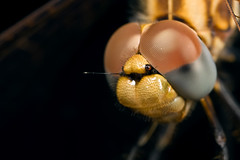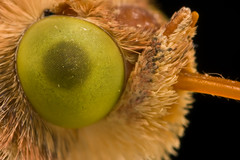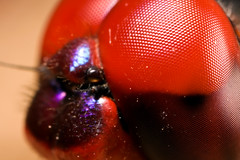koauke writes,
"Hi, I was admiring your macro work and was wondering if I could ask you a question. I'd like to get a macro lens for my Canon XSi (450D) and was wondering if you could give me some advice. Would the Canon 100mm macro be better for insect photography than the 60mm EF-S?"
Here's my responce: In my humble opinion there is no such thing as a bug lens -it's the insect and your ability to get close that will determin if you get the shot and not the working distance of the lens. Having said that I think that lenses in the 100mm range are easier to use for a beginner since there is less of a chance that you are going to cast a shadow over the insect and scare it off. But if you watch the angles that you shoot from the EF-S 60mm is actually a better lens.
The image I've included with this post was taken with the EF-S 60mm + a 250D closeup and an 81A warming filter in natural light (no flash).
Until next time happy shooting :)
Saturday, September 27, 2008
Friday, September 26, 2008
Canon 40D Light Meter Error Example
The small image to the right in this post is the same critter that I'm posting as an example of the 40D's light metering problem when using the MT-24EX. I had to bring the exposure down 2/3 of a stop, so it was possible to recover the shot.
This next photo is the same critter and the exact same scene, but this image is more than two stops over exposed:

Keep in mind that I had the FEC on the MT-24EX set to -2/3 (via the 40D). The exposure wasn't just off because I set it wrong, it varied by two stops for the same scene. To make matters even more interesting is that I can change the 40D from Evaluative E-TTL mode to Average E-TTL mode and the way the 40D exposes a shot with MT-24EX won't change -and that tels me that the MT-24EX is not operating in Evaluative E-TTL mode when connected to the 40D -a problem I never had when shooting with the Xti...
Canon you really need to fix the metering system in the 40D because until you do I can't recommend any of your newer cameras because they could have the same problem. I'm not the only one who's had issues with the 40D and the MT-24 -see this thread at DPR or this post at Fred Miranda ...
This next photo is the same critter and the exact same scene, but this image is more than two stops over exposed:

Keep in mind that I had the FEC on the MT-24EX set to -2/3 (via the 40D). The exposure wasn't just off because I set it wrong, it varied by two stops for the same scene. To make matters even more interesting is that I can change the 40D from Evaluative E-TTL mode to Average E-TTL mode and the way the 40D exposes a shot with MT-24EX won't change -and that tels me that the MT-24EX is not operating in Evaluative E-TTL mode when connected to the 40D -a problem I never had when shooting with the Xti...
Canon you really need to fix the metering system in the 40D because until you do I can't recommend any of your newer cameras because they could have the same problem. I'm not the only one who's had issues with the 40D and the MT-24 -see this thread at DPR or this post at Fred Miranda ...
Sunday, September 21, 2008
Technique
Recently over at the Fred Miranda Macro Forum we were having a friendly discussion about which macro lens is best -and granted, we all know that it's the photographer who makes the image and not the gear. But I couldn't help putting my .02 in for the Canon MPE-65mm macro lens as well as add a few photos to the thread and the original poster had this to say:
“Very nice...I wonder, were these insects glued in place or dead from the freezer?, because I dought the working distance of the MPE 65mm is more than a couple of inches at best and I know how hard it is to capture shy bugs with a lens barrel looming up close to them...”
This was my response:
A fair question. I never shoot dead insects, but I do study the behavior of live critters so I can take advantage of their quirks to get close. With bees I get most of my photos in the early spring when the temperatures are low and the sun dips behind the clouds (the bees need the heat to drive their metabolism)...
5x
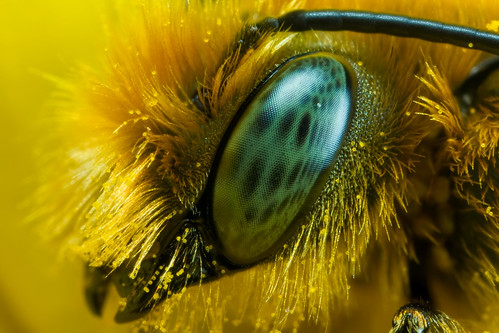
...or after it rains (notice the wet hair)...
2x

...or early in the morning when it's still cool...
2x

...and they are covered in dew...
2x
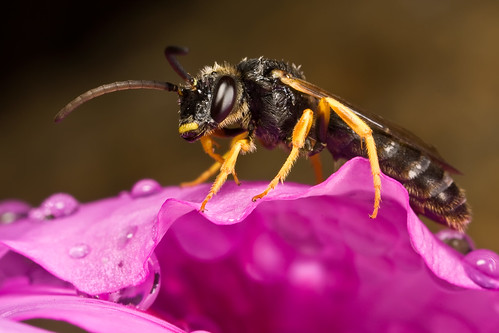
...sometimes they'll even crawl onto your hand to get warm...
2x
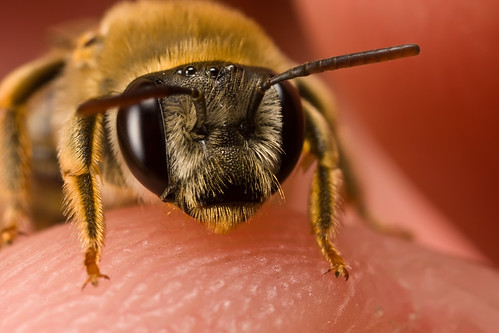
...or shoot late in the day when they have perched for the night (this one is sleeping and I'm holding onto the twig)...
2.5x

...you can even shoot very timid insects when it's windy since they would rather deal with you than the wind...
2x
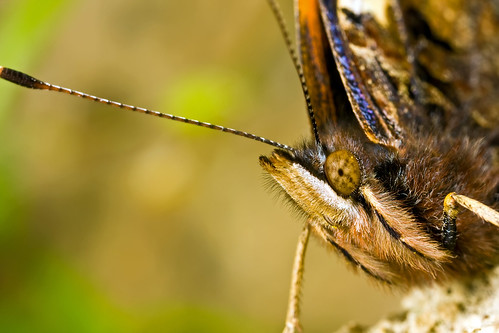
...so you see there really is no such thing as a "bug lens" and that having a short working distance actually allows me to get photos that I wouldn't be able to take with longer glass...
“Very nice...I wonder, were these insects glued in place or dead from the freezer?, because I dought the working distance of the MPE 65mm is more than a couple of inches at best and I know how hard it is to capture shy bugs with a lens barrel looming up close to them...”
This was my response:
A fair question. I never shoot dead insects, but I do study the behavior of live critters so I can take advantage of their quirks to get close. With bees I get most of my photos in the early spring when the temperatures are low and the sun dips behind the clouds (the bees need the heat to drive their metabolism)...
5x

...or after it rains (notice the wet hair)...
2x

...or early in the morning when it's still cool...
2x

...and they are covered in dew...
2x

...sometimes they'll even crawl onto your hand to get warm...
2x

...or shoot late in the day when they have perched for the night (this one is sleeping and I'm holding onto the twig)...
2.5x

...you can even shoot very timid insects when it's windy since they would rather deal with you than the wind...
2x

...so you see there really is no such thing as a "bug lens" and that having a short working distance actually allows me to get photos that I wouldn't be able to take with longer glass...
Sunday, September 14, 2008
40D and the MT-24EX Flash Metering Problem
Early this year I switched from using Canon’s Xti to the 40D and at the same time I was working on getting better diffusion from the MT-24EX. Oddly enough I was having exposure problems with the 40D that I never saw with the Xti: Scenes that the Xti would normally under expose by 1/3 of a stop the 40D would over expose by that same 1/3 of a stop or more. If I took six frames of a scene none of them would be exposed the same and they’d all be over exposed even though it’s normal for me to shoot with the MT-24EX set to -2/3 FEC.
Even shooting against something reflective would give me over exposures even though the camera should have under exposed. At first I thought the 40D was “hyper accurate” and that there was something wrong either with my technique or the diffuser materials that I had used on the twin flashes but as time passed I read more and more people make the same claim –the MT-24EX just doesn’t work well when attached to the 40D. The problem will manifest itself the most when you are shooting a subject when there is very little in the background for the flash to reflect off of –if the background is black in the final image then odds are the subject is completely blown (a problem that I never had with the Xti).
SteB, one of the posters at DP Review mentioned having the same exposure problem that I was seeing and that it seemed like the MT-24EX was operating in Average E-TTL mode instead of Evaluative. Sure enough switching the 40D to Average E-TTL mode seems to give the same exposures as Evaluative in my informal field testing. The work around that I eventually come up with is to make sure that the flash heads were pointed right at the scene I was shooting and to keep one flash head off centered from the top of the lens at the 11 O’clock position and place the other at 2 O’clock (relative to me). The angle of the heads depends on what you’re using for a diffuser –currently I’m using a pair of Sto-Fens over a piece of diffuser plastic that only blocks 2% of the light coming out of the flash. So I position the heads one click up from all the way down at life size and all the way down toward the lens for 2x to 5x shooting. The image included with this post is the result of an entire macro season of trial and error trying to solve the metering problem and get good light quality at the same time…
I’m still not getting consistent exposures, but it’s better than putting one of the flash heads at the very top of the MPE-65mm: It seems like one side of the subject gets thrown into too much shadow so the light meter over compensates for it –badly. If you see some insects with two sets of eyes and eight sets of wings it’s my fault cause the MT-24EX pumped out so much power it altered the critter’s genetics…
I contacted Canon on this issue and they responded to me very quickly –but their solution was for me to send all of my kit into a Canon service center. Unless they test my rig against the same scenes I shoot then they’re not going to see the problem and besides it not just a problem with my camera or flash…
So here's what I need you to do: If you shoot macro with the 40D and the MT-24EX then please respond to this thread at DPR or this post at Fred Miranda and tell me if you are getting consistent exposures or not. If you are then please tell me a little about your technique and the types of scenes you shoot. If enough people post then maybe we can get Canon to take a serious look at the 40D's light meter...
Even shooting against something reflective would give me over exposures even though the camera should have under exposed. At first I thought the 40D was “hyper accurate” and that there was something wrong either with my technique or the diffuser materials that I had used on the twin flashes but as time passed I read more and more people make the same claim –the MT-24EX just doesn’t work well when attached to the 40D. The problem will manifest itself the most when you are shooting a subject when there is very little in the background for the flash to reflect off of –if the background is black in the final image then odds are the subject is completely blown (a problem that I never had with the Xti).
SteB, one of the posters at DP Review mentioned having the same exposure problem that I was seeing and that it seemed like the MT-24EX was operating in Average E-TTL mode instead of Evaluative. Sure enough switching the 40D to Average E-TTL mode seems to give the same exposures as Evaluative in my informal field testing. The work around that I eventually come up with is to make sure that the flash heads were pointed right at the scene I was shooting and to keep one flash head off centered from the top of the lens at the 11 O’clock position and place the other at 2 O’clock (relative to me). The angle of the heads depends on what you’re using for a diffuser –currently I’m using a pair of Sto-Fens over a piece of diffuser plastic that only blocks 2% of the light coming out of the flash. So I position the heads one click up from all the way down at life size and all the way down toward the lens for 2x to 5x shooting. The image included with this post is the result of an entire macro season of trial and error trying to solve the metering problem and get good light quality at the same time…
I’m still not getting consistent exposures, but it’s better than putting one of the flash heads at the very top of the MPE-65mm: It seems like one side of the subject gets thrown into too much shadow so the light meter over compensates for it –badly. If you see some insects with two sets of eyes and eight sets of wings it’s my fault cause the MT-24EX pumped out so much power it altered the critter’s genetics…
I contacted Canon on this issue and they responded to me very quickly –but their solution was for me to send all of my kit into a Canon service center. Unless they test my rig against the same scenes I shoot then they’re not going to see the problem and besides it not just a problem with my camera or flash…
So here's what I need you to do: If you shoot macro with the 40D and the MT-24EX then please respond to this thread at DPR or this post at Fred Miranda and tell me if you are getting consistent exposures or not. If you are then please tell me a little about your technique and the types of scenes you shoot. If enough people post then maybe we can get Canon to take a serious look at the 40D's light meter...
Friday, September 12, 2008
The Diffraction Debate
I’ve contended for years that diffraction, although a real photographic effect and defect, is not the big boogeyman that some people make it out to be –that getting a sharp image circle and controlling motion during the exposure are infinitely more important. It’s also my humble opinion that a lot of what people are calling diffraction is nothing more than “macro motion blur” –slight movement, maybe as little as the width of half a pixel, that robs the image of detail…
I base my opinion on experience –from the time that I started concerning myself with flash duration and making it as short as possible the detail in my images has gone up, like the shot included with this post that was taken at 5x and F11. I’m frequently asked if I focus stack my images due to the level of detail in them and the depth. I played with stacking almost two years ago and didn’t like the effect it had on the background and the overall composition of an image –all of the photos you see in my galleries are single frame. The depth and the sharpness come from carefully controlling where I place the area of acceptable focus and from a short flash duration.
So I know that it’s a myth that the flash duration, no matter how long, can always freeze motion. At the risk of sounding like I have my nose in the air: The proof is in my images…
I can understand why some people would get confused: You’re shooting at 3x, F11, and ISO 100 (the shutter speed isn’t really important since at those settings you’re not going to get any ambient light into the lens anyway). You take a shot and it’s just not as sharp as you’d want it to be, so you drop down to F8 and you’re image has more detail. So diffraction lost, right? Well, there’s just one little problem: When you changed from F11 to F8 the amount of light your flash had to produce to give you a proper exposure dropped in half, so your flash duration for the F8 shot was half as long (or twice as fast) as the flash duration for the shot you took at F11. So did diffraction rob you at F11, or did a “faster virtual shutter speed” defeat motion blur at F8? Hmmm…
Getting your flash closer to the subject, and using a diffuser that diffuses the light instead of just blocking it, will give you shorter flash durations and you just might get the level of detail you’re looking for when shooting at high magnifications and Fstops –but you’ll never try it as long as you believe the diffraction myth…
There’s an interesting thread over at DP Review and another at the Fred Miranda Macro Forum about this very subject. If you want to jump in then do yourself a favor and read the posts carefully –one person already tried to have a go at me by taking something out of context. One of the problems with the current debate on diffraction is that too many people have based their photographic style on the belief that diffraction is a big problem –and some of them don’t want to hear that they might be wrong…
Before I end this post let me make one thing perfectly clear: I don’t care how you take your photos, because how you get from a concept to a shot is irrelevant –the only thing that counts is the final image because that’s the only thing the viewer sees. No matter how this story ends it’s not going to change the way that I take photos since I’ve developed a photographic style that doesn’t require focus stacking –light and composition are infinitely more important than depth of field…
I base my opinion on experience –from the time that I started concerning myself with flash duration and making it as short as possible the detail in my images has gone up, like the shot included with this post that was taken at 5x and F11. I’m frequently asked if I focus stack my images due to the level of detail in them and the depth. I played with stacking almost two years ago and didn’t like the effect it had on the background and the overall composition of an image –all of the photos you see in my galleries are single frame. The depth and the sharpness come from carefully controlling where I place the area of acceptable focus and from a short flash duration.
So I know that it’s a myth that the flash duration, no matter how long, can always freeze motion. At the risk of sounding like I have my nose in the air: The proof is in my images…
I can understand why some people would get confused: You’re shooting at 3x, F11, and ISO 100 (the shutter speed isn’t really important since at those settings you’re not going to get any ambient light into the lens anyway). You take a shot and it’s just not as sharp as you’d want it to be, so you drop down to F8 and you’re image has more detail. So diffraction lost, right? Well, there’s just one little problem: When you changed from F11 to F8 the amount of light your flash had to produce to give you a proper exposure dropped in half, so your flash duration for the F8 shot was half as long (or twice as fast) as the flash duration for the shot you took at F11. So did diffraction rob you at F11, or did a “faster virtual shutter speed” defeat motion blur at F8? Hmmm…
Getting your flash closer to the subject, and using a diffuser that diffuses the light instead of just blocking it, will give you shorter flash durations and you just might get the level of detail you’re looking for when shooting at high magnifications and Fstops –but you’ll never try it as long as you believe the diffraction myth…
There’s an interesting thread over at DP Review and another at the Fred Miranda Macro Forum about this very subject. If you want to jump in then do yourself a favor and read the posts carefully –one person already tried to have a go at me by taking something out of context. One of the problems with the current debate on diffraction is that too many people have based their photographic style on the belief that diffraction is a big problem –and some of them don’t want to hear that they might be wrong…
Before I end this post let me make one thing perfectly clear: I don’t care how you take your photos, because how you get from a concept to a shot is irrelevant –the only thing that counts is the final image because that’s the only thing the viewer sees. No matter how this story ends it’s not going to change the way that I take photos since I’ve developed a photographic style that doesn’t require focus stacking –light and composition are infinitely more important than depth of field…
Subscribe to:
Posts (Atom)


